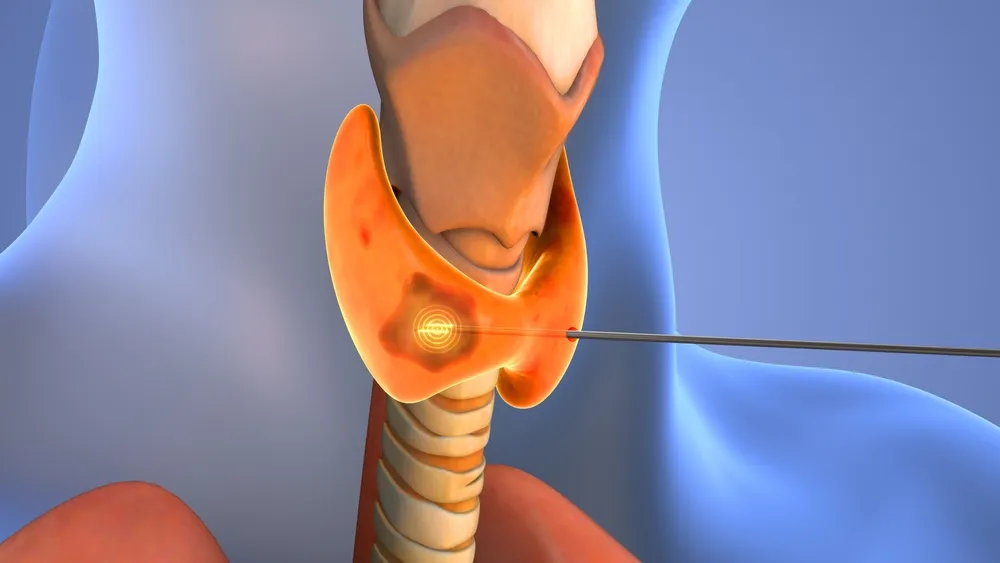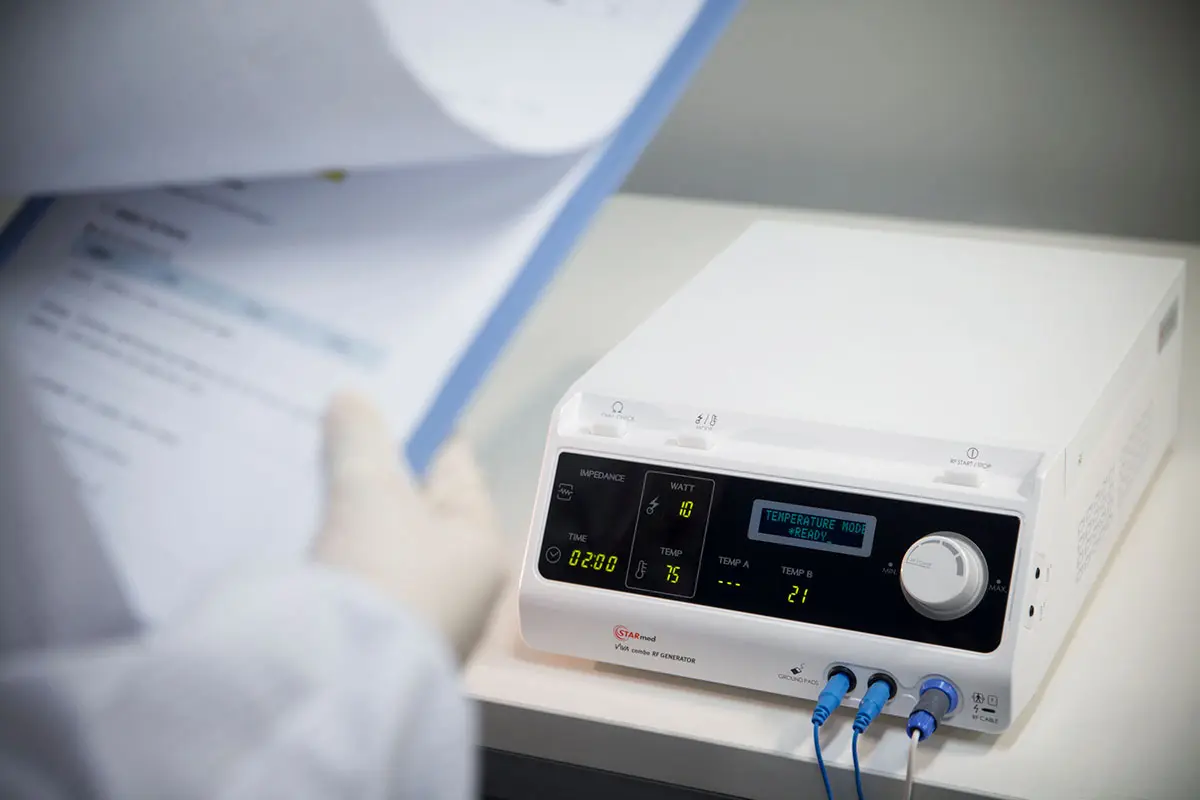TL;DR: Most thyroid nodules are benign and remain harmless, but a small fraction may become or reveal malignancy over time. This article explains how often that occurs, what warning signs to monitor, and when early treatment is appropriate.
- Malignant transformation is rare: Fewer than 1% of benign thyroid nodules later prove cancerous, often reflecting an initial false-negative biopsy rather than true conversion.
- Molecular potential exists: Certain benign adenomas (e.g., follicular, Hürthle cell) can carry genetic mutations linked to thyroid cancer, though this is uncommon.
- Warning signs to re-evaluate: Rapid growth, firm or fixed nodules, voice changes, difficulty swallowing, lymph node enlargement, or high-risk history warrant prompt reassessment.
- Early treatment matters: Surgery should not be delayed when malignancy is suspected, while large or symptomatic benign nodules may benefit from early, minimally invasive treatment such as RFA.
- Surveillance is key: Regular ultrasound follow-up ensures timely detection of rare malignant changes.
- Rapid Nodule Growth. Rapid Nodule Growth: A nodule that enlarges quickly over months is concerning. Significant growth (e.g., >20% increase in at least two dimensions on ultrasound) is a trigger for re-biopsy or intervention.
- Hard or Fixed Nodule. Benign nodules are usually soft or mobile. Invasive cancers can cause a stony hard gland or fixation to nearby structures.
- Hoarseness or Voice Changes. Persistent hoarseness unexplained by other causes is usually related to thyroid cancer invading nerve tissue.
- Difficulty Swallowing or Breathing. While common in large benign goiters, if these symptoms appear with a relatively small nodule or worsen quickly, it should prompt evaluation for malignancy.
- Lymph Node Swelling. The presence of enlarged, hard lymph nodes in the neck along with a thyroid nodule is a red flag.
- Risk Factors. A history of childhood neck irradiation or a family history of thyroid cancer puts a patient at higher risk for a nodule being malignant.
Can a benign thyroid nodule become malignant? The short answer is yes. A benign nodule can become malignant, but it is considered a rare occurrence.
The vast majority of thyroid nodules are benign and remain benign. A very small subset may become cancerous or, more commonly, reveal a hidden malignancy that was present from the start. Although both possibilities are uncommon, neither is impossible, making diligent follow-up crucial after the initial diagnosis of a thyroid nodule.
In this blog, we’ll explain if and how benign thyroid nodules become cancerous. Then, we’ll share details about how often it happens and when early treatment is warranted despite an initial benign diagnosis. Continue reading to understand what to look for when monitoring a patient over time.
Benign vs. Malignant Thyroid Nodules: Prevalence and Key Differences
According to the American Thyroid Association, over 90% of thyroid nodules are benign and never pose a serious cancer threat.
Benign nodules include colloid nodules, cysts, and follicular adenomas, which do not invade surrounding tissues or spread to other parts of the body. Malignant nodules, on the other hand, include papillary or follicular carcinoma. Such nodules can (and often do) grow aggressively and metastasize.
Here is how clinicians initially distinguish between benign and malignant nodules.
Initial Evaluation
When clinicians detect a thyroid nodule, patients undergo an ultrasound and often a fine-needle aspiration (FNA) biopsy to sample cells. Ultrasound imaging can flag suspicious features that raise concern for cancer, such as irregular borders or a taller-than-wide shape. Benign nodules, in contrast, often appear smooth and uniform.
FNA cytology typically classifies nodules as benign, malignant, or indeterminate. If the biopsy is benign, the risk of missing a cancer is low. Researchers cite a false-negative rate of <3%.
Clinical Behavior
Benign nodules tend to grow slowly (if at all). They do not infiltrate other tissues. Any symptoms are typically related to their size, such as pressure in the neck.
Malignant nodules, however, may invade adjacent neck tissues or spread to lymph nodes. Features like a hard, fixed mass in the neck or persistent hoarseness are red flags usually associated with malignancy.
Can Benign Thyroid Nodules Become Cancerous & How Often Does It Happen?

Do benign thyroid nodules become cancerous over time, and if so, how often?
In clinical practice, most truly benign thyroid nodules do not transform into cancer. Long-term follow-up data indicate that the malignant transformation of a previously benign nodule is quite uncommon.
How Often Do Benign Thyroid Nodules Become Cancerous?
Researchers conducted a large 5-year prospective study of nearly 1,000 patients with benign nodules. They found that only 0.3% of those nodules were eventually diagnosed as thyroid cancer during follow-up. Medically, such transformations are considered rare events.
When clinicians do encounter a “benign” nodule later found to be malignant, it often reflects the limitations of the initial testing rather than a true conversion. FNA comes with a small false-negative rate on the order of a few percent. In one series, about 5 to 7% of nodules labeled benign by FNA were ultimately found cancerous upon surgery or extended follow-up. These cases likely had microscopic cancer present from the start.
Can a Benign Thyroid Nodule Become Malignant?
If a thyroid nodule is benign, can it become cancerous? Yes, in rare instances.
Molecular studies have identified genetic mutations and other markers in certain benign thyroid tumors that are also seen in thyroid cancers. This suggests that some benign nodules have latent malignant potential.
For example, follicular adenomas and Hürthle cell adenomas have cellular features resembling cancer. A subset might evolve into carcinoma over many years. Such cases are the exception, not the rule, however. Still, they underscore why ongoing surveillance is advised even after a benign diagnosis.
Warning Signs a Benign Nodule May Not Be Benign
When should you worry that a thyroid nodule is cancerous? Here are key warning signs and risk factors to watch for:
Any combination of the above features merits prompt re-evaluation of the nodule, even if a prior biopsy was benign.
When to Start Treatment Early for a “Benign” Nodule
If clinical or imaging features strongly suggest cancer, even after a benign biopsy, act early.
As a rule, confirmed or strongly suspected malignant nodules are best addressed with surgery. Thyroidectomy is still the gold standard when cancer is a possibility. Early surgical treatment of a thyroid carcinoma offers an excellent prognosis in most cases.
The threshold to move a “benign” nodule to surgery depends on clinical judgment. However, expert consensus is to err on the side of caution when signs point to cancer.
Choose Minimally Invasive Treatment for Benign Nodules
Ultimately, the vast majority of thyroid nodules are benign and will remain that way. In instances in which nodules warrant treatment, minimally invasive options, such as Radiofrequency Ablation (RFA), are available.
As a leader in thyroid RFA technology, STARmed America is committed to helping clinicians stay at the forefront of thyroid nodule care. Learn more about thyroid nodule RFA treatments to ensure patients receive timely, effective therapy without the need for open surgery.





